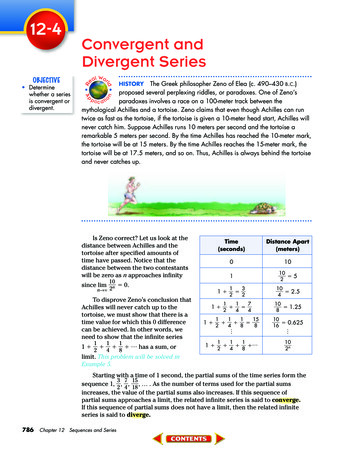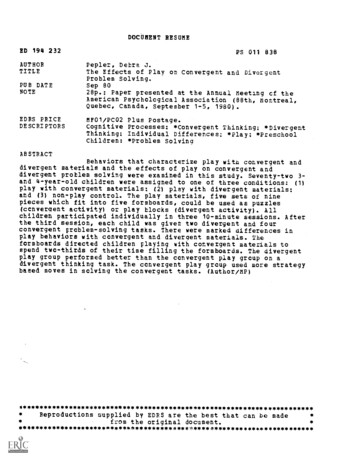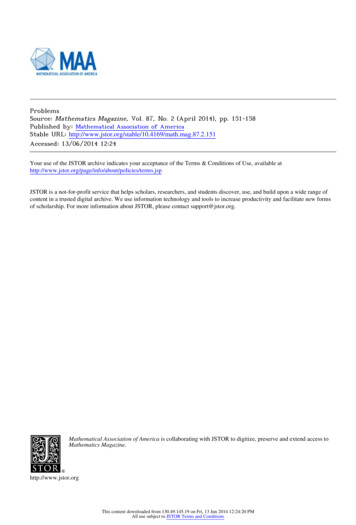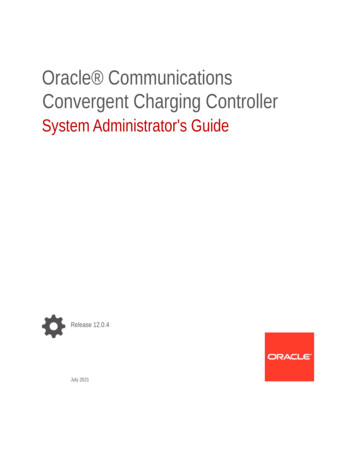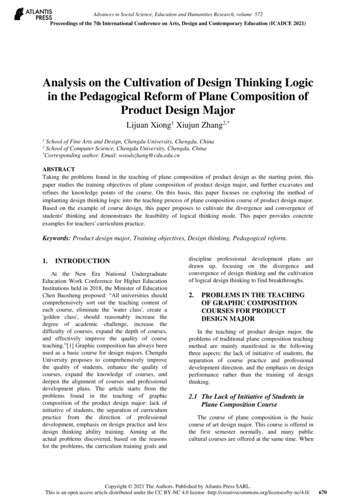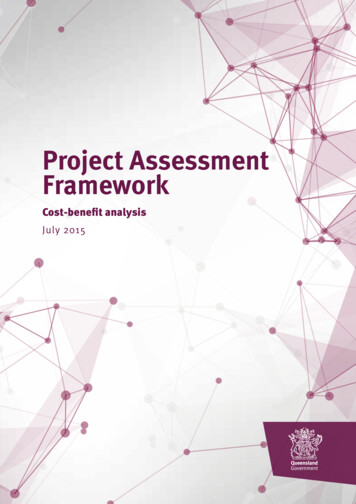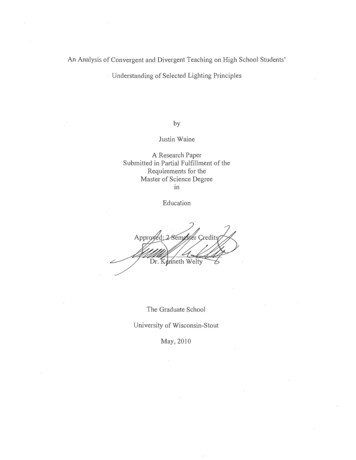
Transcription
An Analysis of Convergent and Divergent Teaching on High School Students'Understanding of Selected Lighting PrinciplesbyJustin WaineA Research PaperSubmitted in Partial Fulfillment of theRequirements for theMaster of Science DegreeInEducationThe Graduate SchoolUniversity of Wisconsin-StoutMay, 2010
2The Graduate SchoolUniversity of Wisconsin-StoutMenomonie, WIAuthor:Waine, Justin T.Title:An Analysis of Convergent and Divergent Teaching on High SchoolStudents' Understanding of Selected Lighting PrinciplesGraduate Degree/ Major: MS EducationResearch Adviser:Kenneth Welty, Ph.D.MonthrYear:May, 2010Number of Pages:57Style Manual Used: American Psychological Association, 6 th editionAbstractThis study was designed to study students ' understanding of selected lightingprinciples when completing a convergent laboratory activity or a divergent laboratoryactivity. The participants included were 60 high school students taking technologyeducation courses at Ellington High School in Connecticut during the spring of2010.Under the auspices of action research, the study was a quasi-experiment with apretest-posttest nonequivalent multiple-group design. The participants first took a pretestwhich included important concepts about lighting. Next, they were divided into twogroups where one group was given a convergent laboratory activity that was verystructured and teacher-directed. The other group was given a divergent laboratory activitythat was open-ended and student-centered. After the laboratory activities were completed,each group took a posttest to demonstrate what they had learned .
3The results of the pretest, posttest, and laboratory activities were analyzed usingdescriptive statistics. Simple frequencies and percentages were used. The study foundthat students who completed the convergent laboratory activity performed better onassessment items that address basic concepts such as shadows, hard light, and soft light.However, the participants that completed the divergent laboratory activity scored higherand performed better on the laboratory tasks and assessment items that targeted advancedconcepts related to portrait lighting.
4The Graduate SchoolUniversity of Wisconsin StoutMenomonie, WIAcknowledgmentsFirst and foremost I would like to thank the students who participated in this study. It isbecause of the students at Ellington High School that I am teaching the subject that I alwaysdreamed of: video production. The video program would not be a success without the hard workthat they put into my classes and the work that they produce.I would also like to thank my parents for their support with graduate school as well as mygirlfriend, Jess. Also, a special thanks to Dr. Kenneth Welty for all his help with all facets of thisproject.
5Table of Contents. . . . PageABSTRACT . . . . . 2List of Tables . . . . . . .7Chapter I: Introduction . 8Statement of the Problem . 9Purpose of the Study . . . . . . . . .9Definition of Terms . . . . 10Limitations of the Study . . 12Assumptions of the Study . . 12Chapter II: Literature Review . . 13Divergent Learning . 13Discovery Learning . . . . 14Inquiry Instruction . 15Convergent Learning . . . . . . . . . . . . . 16Instructional Theory into Practice . 17The Relationship between Convergent and Divergent Teaching . . 18Lighting . . 19Action Research . . 20Chapter III: Methodology . . . . . . 21Research Design . 21Subject Selection and Description . 21Instrumentation . . . 22
6Data Collection Procedures . 22Data Analysis . 23Limitations . 23Chapter IV: Results . 24The Sample . . . . 24Convergent Laboratory . 24Divergent Laboratory . 25Convergent and Divergent Laboratory Performance . 27Chapter V: Discussion . 29Discussion . 30Conclusions . 31Recommendations . 32References . . . . 34Appendix A: Consent Form . 36Appendix B: Lighting Laboratory Pretest. . 37Appendix C: Lighting Laboratory Posttest . 42Appendix D: Convergent Lighting Laboratory . .47Appendix E: Divergent Lighting Laboratory . 53
7List of TablesTable 1: The Sample . . . . 24Table 2: Concepts of Lighting - Convergent Laboratory . . . . .25Table 3: Concepts of Lighting - Divergent Laboratory . 26Table 4: Performance on Laboratory Activities . . . . :. 27
8Chapter I: IntroductionThe goal of technology education is to help students obtain technological literacy.International Technology Education Association (ITEA) defined technological literacy as "theability to use, manage, assess and understand technology" (lTEA, 2007, p. 7). There are manystrategies that technology education teachers use to help their students obtain technologicalliteracy. Two of those ways are through convergent and divergent teaching. Convergent teachingtends to focus on the teacher transmitting the information that they know to the students (BarYam, Rhoades, Sweeney, Kaput & Bar-Yam, 2002). Those students are typically assessed by aformal written test where the only right answer is the one that the teacher gave them. In contrast,divergent teaching focuses on the student and is very student-centered (Bar-Yam, et aI. , 2002).The student uses many resources to find a solution to the problem. The students are activelyinvolved in their own learning and assessment occurs using a variety of evaluation toolsincluding student and teacher observations (Bar-Yam, et aI. , 2002). It is impo11ant to see whichteaching strategy generates the most learning and retention with the students relative to thecontent being taught.Learning effective lighting techniques for a photograph can be a difficult subject forstudents enrolled in a communication technology class to learn. In a convergent approach, ateacher may describe the basic elements of lighting such as key light, fill light, and back lightwith a step-by-step approach on a worksheet. The presentation may show the students exactlywhere to position the lights to properly light a person for a photograph. When a divergentapproach is taken, the students may experiment with many different ideas until they find the bestway that the key light, fill light and back light need to be positioned to take a properly lit
9photograph. When the students are assessed on these selected lighting principles, it is interestingto see which strategy allows the students to construct and retain the most possible information.Statement of the ProblemTechnology education in public schools today is aimed at teaching students how to bemore technological literate and to introduce them to possible careers after high school. Being atechnological literate person is essential in today's world. The study of communicationtechnologies, including photography lighting principles, is part of Ellington High School's effortto address the technological literacy needs of its students. However, little is known about howhigh school students' best learn about celtain concepts such as lighting -- whether it is throughconvergent or divergent instructional strategies. Therefore, the purpose of this study is to look athow convergent and divergent instruction affect student leaming regarding selected principles oflighting. More specifically, the study addresses the following questions:1. What effect does the completion of a convergent lab activity have on studentsunderstanding of selected lighting principles?2. What effect does the completion of a divergent lab activity have on studentsunderstanding of selected lighting principles?3. What are the differences of students understanding of selected lighting principles withthe students who completed the convergent lab activity versus the students who completed thedivergent lab activity?Purpose of the StudyThis study is designed to examine the effects that convergent and divergent instructionhave on high school students' understanding of selected lighting principles during the spring of2010.
10Definition of TermsFor the purpose of this study, the following terms were used as defined :Bac\{ light. Usually placed behind the subject and used to illuminate the person's hair. Italso separates the subject from the background to provide a three-dimensional look. This lightcould be positioned at either 11 :00 or 1:00.Convergent instruction. Traditional methods of teaching where the teacher transmits thenecessary information to the students.Convergent thinking. A way of thinking where the learner draws on their priorknowledge to answer the set of questions.Convergent lab activity. A hands-on learning activity where students were giveninstruction on how to properly light a person in a photograph and set up the lights in a step-bystep process. The students were presented with multiple choice questions to answer as theyproceeded through this activity.Diffused light. Light that bounces or reflects or passes through a surface such as anumbrella, which spreads the light out and creates a soft shadow.Discovery learning. A learning theory where the learner draws on their past experienceand existing knowledge to discover new facts and relationships to be learned. Students are ableto interact with the world to explore and manipulate objects and perform experiments. In thisstudy, students manipulated and arranged the supplied lighting equipment in order to properlylight a person for a photograph.Divergent instruction. A method of instruction where the students are asked to produceas many solutions to the problem as they possibly can. This method is very student-centered.
11Divergent thinking. A way of thinking where the learner looks at a problem andproduces as many possible solutions to the problem as they can.Divergent lab activity. A hands-on learning activity where students were given a set oflights and asked to come up with the solutions for properly lighting a person for a photograph.The students were asked open-ended questions along the way based on their experience.Fill light. A secondary light positioned on the opposite side of the key light and is used tolight the rest of the person's face. It also reduces the shadows caused by the key light. This lightcould be positioned at either 5:00 or 7:00.Gels. Lens or paper that can be placed on a light to either dim or diffuse the light orchange the color of the light if it is a colored gel.Hard light. A small, focused beam of light that shines on a specific area. This type oflight creates a hard shadow that is very crisp, well defined and easy to make out the details of theobject or subject.Key light. The main light used to light a person's face. The purpose of a key light is tohighlight the form and dimension of a subject. This light could be positioned at either 5 :00 or7:00.Light reflectors. A light reflector is used on a light to reflect the light onto an object or aperson. In this study, an umbrella was used as a light reflector.Properly lit person. A properly lit person has the following three types of light on them:key, fill and back. When a person is properly lit, their face and hair will be evenly illuminatedwith no shadows or dark spots on their face .Selected lighting principles. Includes shadows, light reflectors, hard and soft light, key,fill and back light, gels and a properly lit person.
12Soft light. A larger light that shines over a wide area. The shadow created from a softlight source that is very blurry and hard to make out the details of the object or subject.Depending on the light itself, the shadow might also be almost non-existent.Types of light. The two types of light that were examined in this study are hard and softlight.Limitations of the StudyThis study only included students who were enrolled at Ellington High School inEllington, Connecticut, and therefore, the results may not relate to other populations.Assumptions of the StudyThe researcher assumed the convergent and divergent learning activities used in thisstudy represented two discrete approaches that were consistent with the basic tenets of eachapproach. It was also assumed that the assessment tools were valid.
13Chapter II: Literature ReviewThe purpose of this study is to look at how convergent and divergent instruction affectsstudents' understanding of selected lighting principles. The following review of literatureprovided a theoretical foundation for this study. It includes divergent learning, discoverylearning, inquiry based instruction, convergent learning, instructional theory into practice, andlighting.Divergent LearningQuestions that call for an opinion, a hypothesis or an evaluation are classified asdivergent questions (Moore, 2009). These types of questions should be used frequently in theclassroom because they encourage and promote students individual thinking. In fact, this type oflearning and thinking has been associated directly with creative thinking (White, 1990) becauseof the amount of thinlcing required to solve a problem in divergent ways. The students areencouraged to think outside the box and explore various different solutions. This type ofapproach encourages students to be more actively engaged in the learning process since itrequires a broader response than just a simple one word or brief answer (Moore, 2009).Divergent learning is classified as being student-centered and flexible, where the studentsare completely involved in their own learning (Tomar & Sharma, 2005). The students decidehow to complete the assignments given by the teacher and what approach to take with them.Divergent thinking involves taking a topic and breaking it down into its individual parts (Zent,2001). A divergent project may include a portfolio, a commercial to advertise a product, or otherspecial projects that promote more than one answer to the problem that is given (Tomar &Sharma, 2005).
14Kwon, Park, and Park (2006) looked at how divergent teaching can be applied tomathematics. Traditionally, especially in mathematics, students are taught that there is only onecorrect solution to a problem. K won et a1. (2006) looked at the three components of divergentthinking, which includes flexibility, fluency, and originality. It was discovered that through theuse of open-ended problems in mathematics, coupled with open-ended questions, can greatlyincrease divergent thinking skills. These types of questions were found to be particularly goodfor differentiated classrooms because they can be designed to encourage all students to use anddemonstrate mathematical creativity (Kwon et aI., 2006).Discovery LearningDivergent instruction is often equated with discovery learning. There are manydefinitions of discovery learning, two of which are applied to this study. One common definitionof discovery learning is when the learner is presented with the tools and information to solve aproblem and then the learner is to make sense of them (Bardin, n.d.). Discovery learning usesinductive reasoning by starting with specific information and asks the learner to generalize whatthey have just learned and apply it to other situations (Merrill Education, n.d.). It is the job of theinstructor to present the learners with many examples until they discover the interrelationshipsbetween them.According to Bardin (n.d.), another definitions that is commonly used for discoverylearning is the learner uncovers something based on an activity that has been designed by theinstructor to facilitate the discovery. In order to use discovery learning using this method, theteacher presents examples of what does not fit and examples that do fit the concept in question(MelTill Education, n.d.). Discovery learning encourages the learner to relying on his or her past
15experiences and prior knowledge to help him or her discover the new knowledge, skills, andtruths to be learned (Bardin, n.d.).There are many advantages to discovery learning in the classroom. Bruner (1967) says itmotivates students by actively involving them in the leaming process. Instead of learners justreading about a specific topic, they are actually taking the materials and tools provided by theteacher and creating their own example to illustrate the concepts. They conduct experiments totest the information and then draw conclusions based on how those experiments performed.According to Bruner (1967), it also helps students develop and enhance their problem solvingand critical thinking skills. Discovery learning also creates an individualleaming experience forthe students because they learn what they need to in order to accomplish the task given by theteacher and it also encourages the students to go much deeper (Bruner, 1967). They may end uplearning much more than the teacher intended. This, in turn, would give the students an evendeeper understanding of the particular concepts or topics that they were studying.Inquiry InstructionDivergent teaching relates directly to inquiry instruction, which is currently at theforefront of science education reform (Bell, Smetana & Binns, 2005). The National ScienceEducation Standards stated inquiry instruction involves students in a variety of active learningactivities which emphasizes questioning, data analysis, and critical thinking (Bell et aI., 2005).Colburn (2000) describes inquiry instruction as a process where students are actively engaged inessentially open-ended and student-centered hands on activities. In this process, the students areencouraged to do their own research to solve their own problems and to answer questions forthemselves. The teacher may choose to give the students the data and the activity would still beconsidered inquiry based if the students are analyzing and drawing their own conclusions based
16on the data. The main goal of inquiry instruction is to help students improve their inquiry skills(Bell et aI., 2005).Colburn (2000) and Bell et ai. (2005) described four levels of inquiry. The lowest level ofinquiry is called a confirmation activity. The students are presented with the questions and theprocedure and the results of the activity are known in advance (Bell et aI., 2005). This type ofinquiry helps to reinforce a concept that the students have already learned. In structured inquiry,students are given a step-by-step procedure with diagrams for the activity. Students maymanipulate the objects in the activity and record their observations (Colburn, 2000). The nextform of inquiry is called guided inquiry, where the students are given various materials and areasked to find as many solutions as possible to a problem that has been posed. The procedures aregiven and the students read them to understand how to begin the activity. They may be asked tomanipulate their findings and record what they find out as a result of their manipulation(Colburn, 2000). The teacher presents the students with a list of questions that they need toanswer (Bell et aI., 2005). The highest level of inquiry is called open inquiry, where the studentsare given the materials and instructed to find answers using those materials. The methods,problems, and solutions are left up to the student to figure out (Bell et aI., 2005). Students cannotbe expected to start off with the highest level of inquiry. They need to practice in the lower levelsbefore moving to the higher levels of inquiry (Bell et aI., 2005).Convergent LearningConvergent learning is when the students are taught that there is only one correct answerto a problem or question (Moore, 2009). Questions such as true and false or yes and no can alsobe classified as convergent questions because they only solicit one answer. Questions asked in a
17convergent manner are very imp011ant because they target the preliminary information thatstudents need to address a more complex question (Moore, 2009).Convergent teaching is mostly centered on the teacher directly transmitting theknowledge to the students (Tomar & Sharma, 2005). This style of instruction is extremelyteacher-centered and very structured. It is also the most familiar type of teaching to students andteachers. The ability to learn the information presented is assessed using standardized tests(Tomar & Sharma, 2005). Convergent thinking involves taking the different pieces of aparticular topic and putting them back together in an organized, structured, and understandablefashion (Zent, 2001). Zent (2001) argues convergent thinking is an essential part of the outliningand organizing process.Instructional Theory into PracticeConvergent learning and teaching relates directly to Madeline Hunter's InstructionalTheory into Practice (ITIP) model. This model was very popular in the nineties and wasconsidered a teacher decision making model, where the teacher made all of the decisionsregarding what the students will be learning (Wessman, n.d.). The teacher first starts by deciding,based on the content standards and grade level, what information the students will be learningand therefore, what will be taught. They also decide what the student will do to demonstrate whatthey have leal11ed (Wessman, n.d.). Finally, the teacher also decides, based on research andcunent methods in education, how to deliver that content to the students (Wessman, n.d.).According to Hunter (1994), the lesson first needs to be developed with an instructionalobjective in mind. The objective must be based on Bloom's taxonomy of learning domains,which includes cognitive, affective, and psychomotor activities (Bloom, 1956). After theobjective is set, an anticipatory set must be completed in order to get students engaged in the
18lesson (Hunter, 1994). The lesson objectives are then stated to students so they have an idea ofwhat the teacher expects they will know or be able to do by the end of the lesson. The teacher, ina direct instruction format, teaches the students the main concepts or skills that they havedetelmined are important for the students to know. Students are invited to paliicipate in thelesson by asking questions and answering the questions posed by the teacher. Examples anddiagrams are used as much as possible during the lesson (Hunter, 1994). During the lesson theteacher may also check for student understanding by interpreting their reactions and responses toquestions asked. At some point in the lesson, students are encouraged to engage in discussions,to solve problems or to demonstrate a skill (Hunter, 1994). At this point in the lesson, the teachercan determine whether or not the students understand the material and can re-teach it ifnecessary. Once students have demonstrated understanding of the particular topic, then theteacher can assign independent practice to strengthen their skills and knowledge in that particulararea (Hunter, 1994). Hunter (1994) notes that it may take several lessons for the students tobecome ready for guided or independent practice on the material that they have just learned.The Relationship between Convergent and Divergent TeachingIn today's educational environment, there tends to be a push more towards convergentteaching (Tomar & Sharma, 2005) because of the need to have high scores on standardized tests.Tomar and Sharma (2005) argue that both a convergent approach and a divergent approach areneeded. The convergent teaching gives students the background knowledge in order to completethe divergent project or activity. Both of these approaches need to be used since there are somestudents that may perform very well in a convergent setting but not well in a divergent setting,and vice-versa. In a classroom where only convergent teaching is happening, some students mayattain the knowledge given by the teacher while others may fall by the wayside or given some
19sOli of remediation with limited results (Bar-Yam, et al., 2002). Tomar and Sharma (2005) calledthis style of teaching guided-divergent, meaning that it is more structured and less flexible thandivergent teaching but less nan-ow and limiting than convergent teaching.Rintelman (2007) found that middle school technology education students performedbetter on the convergent laboratory activity than the divergent laboratory with the topic ofmechanisms. The results of his study suggested middle school students tend to follow a moreteacher prescribed path to answering the questions rather than a student centered one. This pathto understanding is consistent with convergent teaching and learning (Rintelman, 2007). Middleschool students tend to be more concrete thinkers than abstract thinkers, which is why theysometimes have trouble using inquiry instruction to understand certain concepts (Colburn, 2000).The students who completed the divergent laboratory activity tended to be confused, found theactivities difficult, and were unable to draw conclusions from their experiences. Rintelman(2007) also suggested that the types of questioning asked during laboratory activities couldinfluence the results. On the convergent laboratory the students were asked multiple choicequestions and on the divergent laboratory they were asked open ended questions. Middle schoolstudents in general were found to have more difficulty answering the open ended questionsversus the multiple choice questions (Rintelman, 2007).LightingIt is important for all students to develop a sense of technological literacy. Morespecifically, they need to understand how technology works and how to manipulate for the taskat hand (lTEA, 2007). Lighting a photographic subject and understanding how light works aretechnological, scientific, and aliistic concepts. From a technological perspective, they includesystems, resources, requirements, optimization an
convergent or divergent instructional strategies. Therefore, the purpose of this study is to look at how convergent and divergent instruction affect student leaming regarding selected principles of lighting. More specifically, the study addresses the following questions: 1. What effect does the completion of a convergent lab activity have on .

